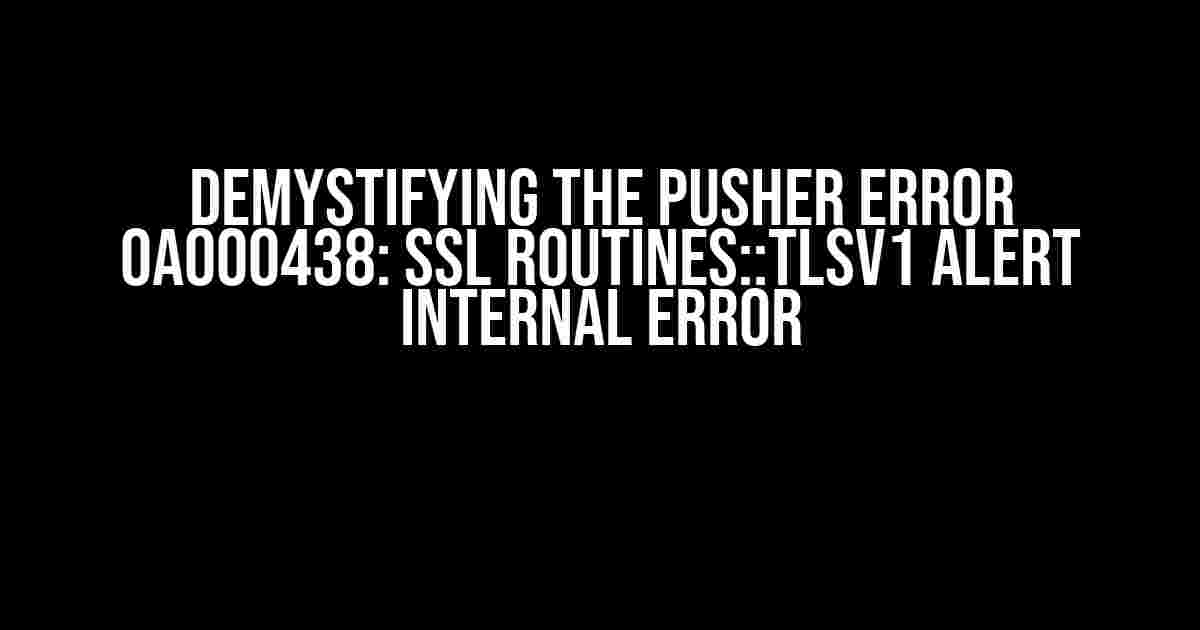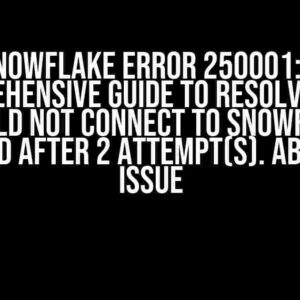Are you tired of receiving the cryptic error message “Pusher error 0A000438: SSL routines::TLsv1 alert internal error” whenever you try to integrate Pusher into your application? Well, worry no more! In this article, we’ll delve into the world of SSL/TLS, explore the causes of this error, and provide you with a step-by-step guide on how to fix it.
What does the error message mean?
The error message “Pusher error 0A000438: SSL routines::TLsv1 alert internal error” might seem like a jumbled mess of words, but it’s actually a symptoms of a deeper issue. Let’s break it down:
Pusher error 0A000438: This is the specific error code generated by Pusher’s API.SSL routines: This refers to the SSL/TLS (Secure Sockets Layer/Transport Layer Security) protocol, which is responsible for encrypting data transmitted between your application and Pusher’s servers.TLsv1 alert internal error: This indicates that an internal error occurred during the TLSv1 (Transport Layer Security version 1) handshake process.
The TLsv1 Handshake Process
To understand the root cause of the error, let’s take a brief look at the TLsv1 handshake process:
1. Client Hello: The client (your application) sends a "hello" message to the server (Pusher) to initiate the connection. 2. Server Hello: The server responds with its own "hello" message, which includes the supported protocols and cipher suites. 3. Certificate: The server sends its SSL/TLS certificate to the client. 4. Certificate Verify: The client verifies the server's certificate. 5. Key Exchange: The client and server exchange cryptographic keys. 6. Change Cipher Spec: Both parties switch to the new encryption keys. 7. Finished: The client and server send "finished" messages to confirm the handshake.
Somewhere during this process, an internal error occurs, causing the Pusher API to return the dreaded error message.
Causes of the Error
Now that we’ve demystified the error message, let’s explore the possible causes:
- Outdated SSL/TLS Version: Pusher has deprecated support for TLSv1 and TLSv1.1 due to security concerns. If your application is using an outdated version, it might be causing the error.
- Invalid or Missing SSL Certificate: A misconfigured or absent SSL certificate can lead to certificate verification issues, causing the internal error.
- Incompatible Cipher Suites: Using outdated or incompatible cipher suites can disrupt the handshake process, resulting in the error.
- Network Connectivity Issues: Temporary network outages or misconfigured firewalls might prevent the handshake from completing successfully.
- Pusher API Configuration: Misconfigured Pusher API settings, such as an incorrect cluster or instance, can lead to the error.
Solutions to the Error
Now that we’ve identified the possible causes, let’s dive into the solutions:
Update to TLSv1.2 or Higher
If you’re using an outdated SSL/TLS version, update to TLSv1.2 or higher. Here’s how:
// In your application, update the SSL/TLS version to TLSv1.2 or higher
// For example, in Node.js using the `https` module:
const https = require('https');
const agent = new https.Agent({
secureProtocol: 'TLSv1_2_method'
});
Verify and Update SSL Certificates
Ensure your SSL certificate is valid and properly configured. You can check your certificate using tools like OpenSSL:
// Using OpenSSL to verify the SSL certificate openssl s_client -connect yourdomain.com:443
If your certificate is invalid or missing, obtain a new one from a trusted certificate authority and configure it correctly.
Use Compatible Cipher Suites
Update your cipher suites to compatible ones. You can use tools like OpenSSL to list the supported cipher suites:
// Using OpenSSL to list supported cipher suites openssl ciphers -v
Update your application to use compatible cipher suites, such as:
// In your application, update the cipher suites
// For example, in Node.js using the `https` module:
const https = require('https');
const cipherSuites = [
'TLS_ECDHE_ECDSA_WITH_AES_256_GCM_SHA384',
'TLS_ECDHE_RSA_WITH_AES_256_GCM_SHA384'
];
const agent = new https.Agent({
ciphers: cipherSuites.join(':')
});
Check Network Connectivity and Firewall Configuration
Verify that your network connection is stable and not blocked by firewalls. Check your firewall configurations to ensure they allow outgoing connections to Pusher’s servers.
Verify Pusher API Configuration
Double-check your Pusher API settings, ensuring that you’re using the correct cluster, instance, and credentials.
| Pusher API Setting | Check |
|---|---|
| Cluster | Verify the cluster is correct and matches your Pusher account. |
| Instance | Ensure the instance is correctly configured and matches your Pusher account. |
| Credentials | Check that your API key, secret key, and app ID are correct and match your Pusher account. |
Conclusion
The Pusher error 0A000438: SSL routines::TLsv1 alert internal error can be frustrating, but by following the steps outlined in this article, you should be able to identify and fix the root cause of the issue. Remember to update your SSL/TLS version, verify and update your SSL certificates, use compatible cipher suites, check your network connectivity and firewall configuration, and verify your Pusher API settings.
By applying these solutions, you’ll be able to establish a secure connection with Pusher’s servers and resolve the error. Happy coding!
Frequently Asked Question
We’ve got you covered! Get answers to the most common questions about “Pusher error 0A000438:SSL routines::tlsv1 alert internal error”
What is the “Pusher error 0A000438:SSL routines::tlsv1 alert internal error” and why does it occur?
The “Pusher error 0A000438:SSL routines::tlsv1 alert internal error” is a common error that occurs when there’s a misconfiguration or mismatch between the SSL/TLS version used by the client and the server. This error is usually caused by a outdated or expired SSL certificate, incorrect certificate chain, or a protocol mismatch between the client and server.
How do I fix the “Pusher error 0A000438:SSL routines::tlsv1 alert internal error”?
To fix this error, you’ll need to identify and resolve the root cause. Check your SSL/TLS certificate configuration, ensure it’s up-to-date and correctly chained. Additionally, verify that the protocol version used by the client and server is compatible. You may also need to update your Pusher library or SDK to the latest version to ensure it’s compatible with the latest TLS versions.
What are the common consequences of ignoring the “Pusher error 0A000438:SSL routines::tlsv1 alert internal error”?
Ignoring this error can lead to security vulnerabilities, data encryption issues, and even connection failures. It may also cause compatibility problems with modern browsers and devices that require the latest TLS versions. In extreme cases, it can lead to a complete disruption of your application or service, resulting in revenue loss and damage to your brand reputation.
Can I prevent the “Pusher error 0A000438:SSL routines::tlsv1 alert internal error” from occurring in the first place?
Yes, you can prevent this error by ensuring your SSL/TLS certificate is up-to-date, correctly configured, and compatible with the latest TLS versions. Regularly update your Pusher library or SDK, and ensure your server and client configurations are compatible. Additionally, perform regular security audits and penetration testing to identify potential vulnerabilities before they become a problem.
What are some best practices to avoid SSL/TLS-related errors like the “Pusher error 0A000438:SSL routines::tlsv1 alert internal error”?
Best practices to avoid SSL/TLS-related errors include using strong, up-to-date, and compatible certificates, configuring your server and client to use the latest TLS versions, regularly updating your Pusher library or SDK, and performing regular security audits and penetration testing. Additionally, consider implementing a robust monitoring and logging system to quickly identify and respond to potential errors.




